Table of Contents
Industrial flotation machines can be divided into four classes:
- mechanical
- pneumatic
- froth separation
- column
- air-lift
- matless
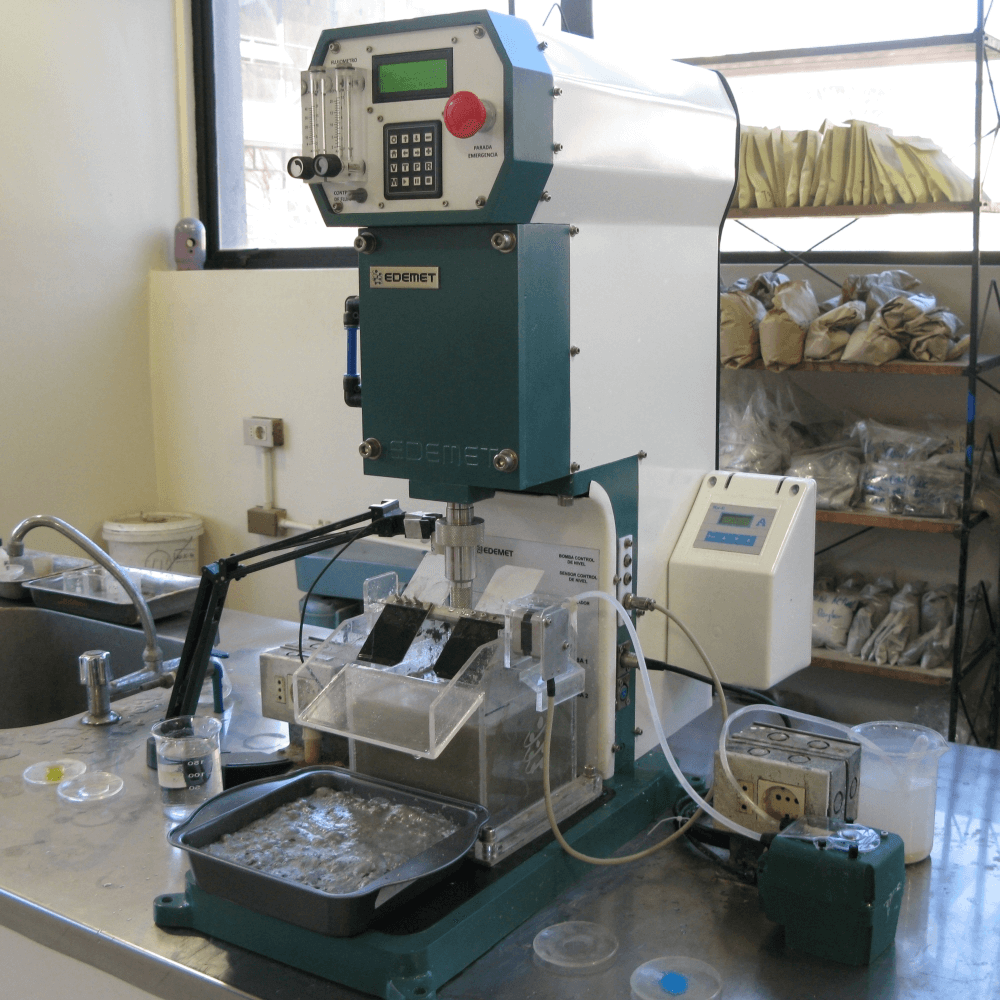
As pneumatic and froth separation devices are not commonly used in industry today, no further discussion about them will be given in this module. The mechanical machine is dearly the most common type of flotation machine currently used in industry, followed by the column machine which has recently experienced a rapid growth.
A mechanical machine consists of a mechanically driven impeller that disperses air into the agitated pulp. In normal practice this machine appears as a long tank-like vessel having a number of impellers in series. Mechanical machines can have open flow of pulp between the impellers or can be of cell-to-cell design with weirs between them. Below is a typical bank of flotation cells used in industrial practice.
The procedure by which air is introduced into a mechanical machine falls into two broad categories: self-aerating, where the machine uses the depression created by the impeller to induce air, and supercharged, where air is generated from an external blower. The incoming feed to the mechanical flotation machine is usually introduced in the lower portion of the machine. At the very below is shown a typical flotation cell of each air delivery type (Agitair & Denver)
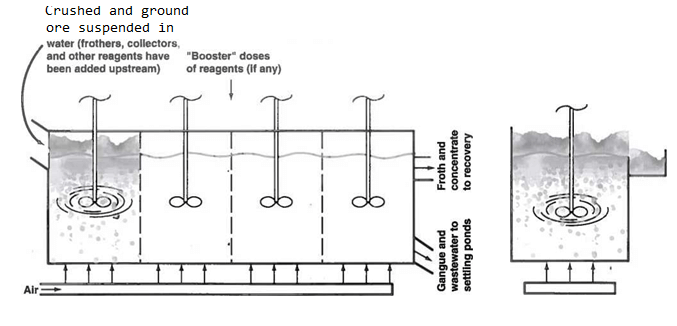
The most rapidly growing class of flotation machine is the column machine, which is, as its name implies, a vessel having a large height-to-diameter ratio (from 5 to 20) in contrast to mechanical cells. This type of machine provides a counter-current flow of air bubbles and slurry with a long contact time and plenty of wash water. As might be expected, the major advantage of such a machine is the high separation grade that can be achieved, so that column cells are often used as a final concentrate cleaning step. Special care has to be exercised in the generation of fine air bubbles and the control of the feed rate to the column cell for such cells to be effective. Column cell use is often of limited value in the recovery of relatively coarse valuable particles; because of the long lifting distances involved, the bubbles can not carry large particles all the way to the top of the cell.
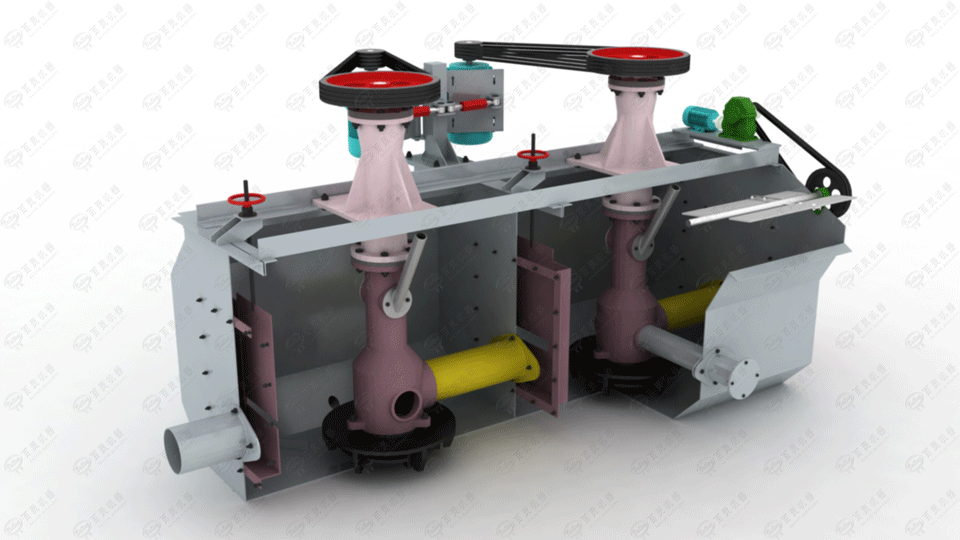
Whatever flotation machine design is chosen, it must perform a series of complicated functions. Some of the more obvious are:
- Good mixing of pulp. To be effective, a flotation machine should maintain all particles uniformly in suspension within the pulp, including those of relatively high density anchor size. Good mixing of pulp is required for maximizing bubble-particle frequency.
- Appropriate aeration and dispersion of fine gas bubbles. An important requirement of any flotation machine is the ability to provide uniform aeration throughout as large a volume of the machine as is possible. In addition, the size distribution of the gas bubbles generated by the machine is also important, but experience has shown that the proper choice of frother type and dosage generally dominates the bubble size distributions being produced.
- Sufficient control of pulp agitation in the froth zone. As mentioned earlier, good mixing in the machine is important. However, equally important is that near and in the actual froth bed at the top of the machine, sufficiently smooth or quiescent pulp conditions must be maintained to ensure suspension of collector-coated particles
- Efficient mass flow mechanisms. It is also necessary with any flotation machine that appropriate provisions be made for feeding pulp into the machine and also for the efficient transport of froth concentrate and tailing slurry away from the machine.
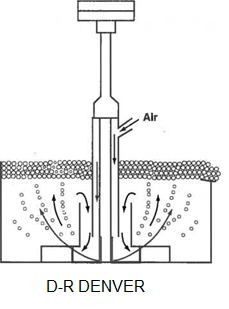
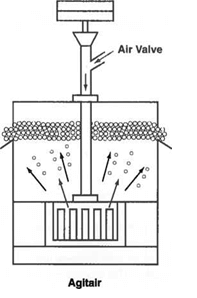
Probably the most significant area of change in mechanical flotation cell design has been the dramatic increase in machine cell volume with a single impeller. The idea behind this approach is that as machine size increases (assuming no loss of recovery performance with the larger machines), both plant capital and operating cost per unit of throughput decrease. In certain industrial applications today, cells of even a thousand cubic meters in volume (a large swimming pool) are being used effectively.
The throughput capabilities of various cell designs will vary with the flotation machine’s residence time and pulp density The number of cells required for a given operation is determined from standard engineering, mass balance calculations. In the design of a new plant, the characterization of each cell’s volume and flotation efficiency is generally calculated from data gathered on a laboratory scale flotation using the same type of equipment for the same material mixture in question. This procedure is then followed by the application of semi-empirically derived scale-up factors. Research work is currently under way to improve the understanding and performance of commercial flotation cells.
Currently, flotation cell design is primarily a proprietary material of the various cell manufacturers. Flotation plants are built in multiple cell configurations (called banks), and the flow through the various banks is adjusted in order to optimize plant recovery of the valuable as well as the grade of the total recovered mass from flotation. Up above is a typical flotation bank scheme. The total layout of a given flotation plant (including all of the various banks) operating on a given feed is called a flotation circuit.
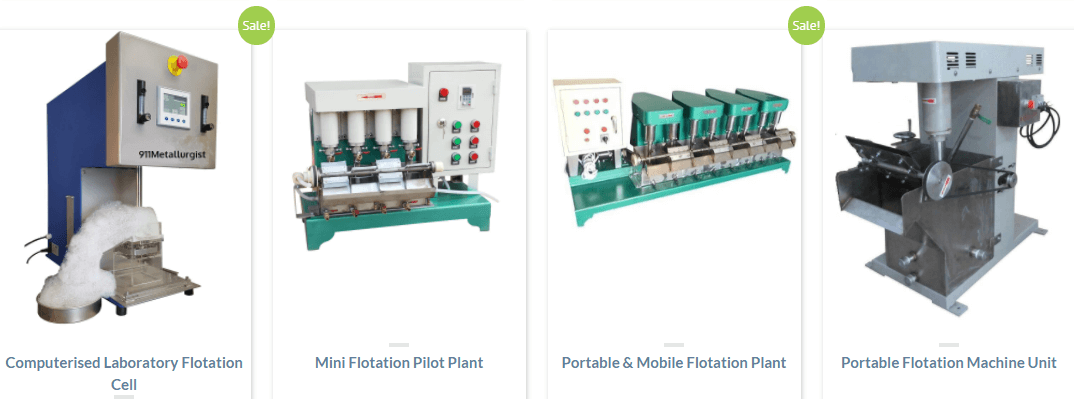
Air Lift Flotation Machines
The application of the air-lift to flotation is not new, but the first attempts to make use of the principle were not successful because the degree of agitation in the machine was insufficient to enable the heavy oils then in use as collecting reagents to function effectively. The advent of chemical promoters, however, made agitation of secondary and aeration of primary importance, with the result that the application of the air-lift principle became practicable and led to the introduction of the Forrester and the Hunt matless machines. South – western Engineering Corporation are the owners in most countries of the rights to license and manufacture these and other types operating on the air-lift principle, and they have developed a machine based chiefly on the Welsh and Hunt patents which may be considered as representative of the type that is now most commonly used.
Southwestern Air-Lift Machine
The Southwestern Air-Lift Machine, as it is called, consists of a V-shaped wood or steel trough of any length but of the standard cross-section shown in Fig. 40, the area of which is 9.85 sq. ft. and the interior depth 36 in. Low- pressure air is delivered from a blower through a main supply pipe to an air-pipe or “header” which runs longitudinally over the top of the machine. The air enters the trough itself through a series of vertical “ down-pipes ”, which are screwed into sockets welded to the underside of the header at 4-in. intervals along its length and are open at their lower ends. They are from ¾ to 1 in. in diameter for roughing machines and from ½ to ¾ in. for cleaners, and they reach to within 6 in. of the bottom. The air-lift chamber is formed by two vertical partitions, one on each side of the line of down-pipes, both of which extend from one end of the trough to the other, forming a compartment 6 in. wide. The lower edges of the partitions are an inch or two above the ends of the down-pipes and their upper edges are about level with the froth overflow lips at each side of the machine. A few inches above the top of the air-lift chamber is a deflector cap which serves to direct the rising pulp outwards and downwards against two vertical baffles. These extend the length of the trough parallel to and outside the partitions, their lower edges being several inches below the normal pulp level. The space between the baffles and the sides of the machine forms two spitzkasten- shaped zones of quiet settlement where the froth collects.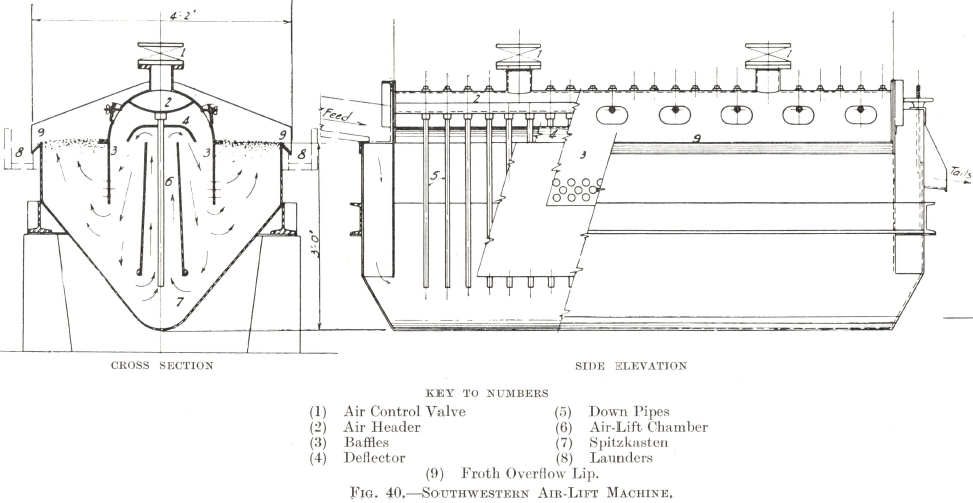
The feed enters near the bottom of one end of machine and the tailing is discharged over an adjustable weir at the other end. The air, issuing in a continuous stream from the open ends of the down-pipes, carries the pulp up the central chamber on the principle of an air-lift pump. The air is subdivided into minute bubbles and more completely mixed with the pulp as the rising mass hits the cap at the top and is deflected and cascaded on to the baffles at each side, which direct it downwards, distributing the bubbles evenly throughout the pulp in the body of the machine and giving them ample opportunity to collect a coating of mineral. Rising under their own buoyancy, the bubbles enter the spitzkasten zones, up which they travel without interference, dropping most of the gangue particles mechanically entangled between them as they ascend. They collect on the surface of the pulp at the top as a mineralized froth, which is voluminous enough to pass over the lip into the concentrate launders without the need of scrapers. The pulp, on the other hand, continues its downward passage and enters the air-lift chamber again. In this way a continuous circulation of the pulp is maintained, its course through the machine being more or less in the form of a double spiral.
The aeration is generally controlled by a single valve in the header of each machine, but for selective flotation the machine is sometimes divided by transverse partitions into sections 4 ft. long, the header over each section being provided with a separate air-valve. The depth of the froth is regulated by means of the adjustable gate of the tailing weir. If difficulty is likely to be experienced in making a clean tailing with the normal amount of aeration, it is preferable to use two machines. The second one is run as a scavenger with an excess of air as compared with normal requirements, the low-grade froth so produced being pumped back to the head of the primary or roughing machine, in which the aeration is more normal in order that a comparatively clean concentrate may be produced. It is often possible to take a concentrate off the first few feet of the rougher rich enough to be sent to the filters as a finished product, the froth from the rest of the machine being pumped back to the head. When this method of flotation is adopted, it is an advantage to have the header divided into sections, each with its own valve, so that the aeration can be varied along the length of the machine. By increasing the volume of air at the discharge end the froth can be given a slight flow towards the head of the machine, with the result that the minerals are concentrated there to the exclusion of partially floatable gangue which might otherwise enter any bubbles not fully loaded with mineral.
If the froth from the feed end of the rougher is not of high enough grade, it must be re-treated in a separate cleaning machine, the length of which usually varies from one-quarter to one-half of the total length of the roughing and scavenging machines according to the amount of concentrate to be handled. Should still further cleaning be necessary, it is performed in a recleaner, which is generally of the same length as the cleaner. The tailings from these operations are often, but not necessarily, returned to the head of the rougher.
It is usual to prepare the pulp for flotation by adding the reagents to the grinding circuit or in a conditioning tank ahead of the flotation section, but soluble frothers such as pine oil and quick-acting promoters such as the xanthates can be added at the head of the machine if desired, since the air-lift provides enough agitation to emulsify and distribute them throughout the pulp. It is not as a rule advisable to introduce reagents into the air-lift chamber itself ; should it be necessary to do so to obtain a satisfactory recovery of the minerals, it is best to employ separate roughing and scavenging machines and to make the extra additions at the head of the scavenger.
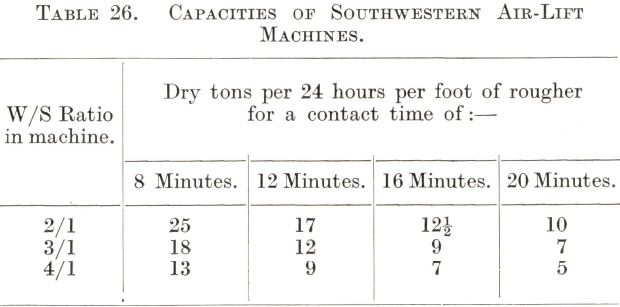
Southwestern Air-Lift Machines are made of standard cross-section, as already stated, and in a series of lengths ranging, for ordinary purposes, from 4 to 48 ft. There is no limit to the possible length, however, and 100-ft. machines are in actual use. The tonnage capacities under different conditions will be found in Table 26. The pressure of air needed at the machine is from 1.6 to 1.7 lb. per square inch, which under normal conditions requires a pressure of about 2 lb. per square inch at the blower. It is usual to allow 75 to 100 cu. ft. of free air per minute at this pressure per foot of rougher and 45 to 70 cu. ft. per minute per foot of cleaner and recleaner. From these figures the approximate volume of air required for a machine or machines of any given length can be calculated. The power necessary to supply the air can then be found from Table 30.
Matless Flotation Machine
The Callow Cell consists of a shallow horizontal trough, the bottom of which is covered with a porous medium, usually termed a “blanket”, consisting of a few layers of canvas or of a sheet of perforated rubber. Air is introduced at low pressure under the blanket, and, in passing through it, is split up into minute bubbles, which rise through the pulp in the cell, collecting a coating of mineral in the process.
Fig. 41 shows a section of the type of cell commonly employed. Its width is usually from 24 to 36 in., and its interior depth from 18 to 22 in. measured from the overflow lip ; the length varies according to requirements and is generally a multiple of the width. On the bottom are placed, side by side, the square open-topped cast-iron blanket frames or “ pans ”. The blanket covering the top of each pan is securely held in place by flat iron strips bolted round the edges, while one or two pipe grid-bars across the top prevent it from bulging. This arrangement allows a blanket to be changed in a few minutes should it become damaged. The air inlet to each pan projects through the bottom of the cell and is connected by a pipe and regulating valve to a header, which is provided with a main control valve.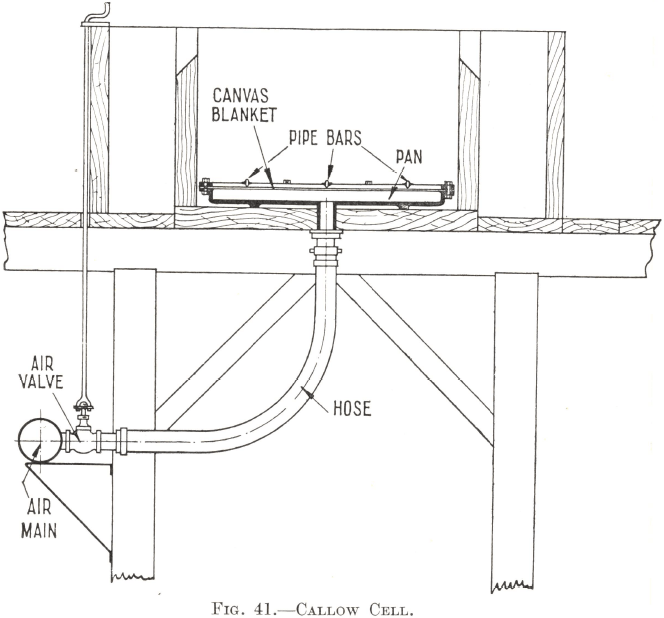
The pulp enters one end of the cell through a feed opening and is discharged over an adjustable weir at the other end. There is no agitation, but the continuously rising stream of air bubbles keeps the particles of ore in suspension and induces a certain amount of circulation as the pulp passes along the cell. In this way the minerals are given many chances of becoming attached to the bubbles and thus of being carried over into the concentrate launder. The froth that forms on the surface of the pulp, usually to a depth of 8 to 10 inches, is voluminous enough to overflow the lips on each side of the cell without the use of mechanical scrapers.
For estimating purposes the average capacity of a Callow Cell may be taken as 2.5 tons of feed per square foot of blanket area per 24 hours and the air consumption as 9 cu. ft. of free air per minute per square foot of blanket at a pressure of 4 lb. per sq. in. A greater pressure is likely to be required if the blankets become “ blinded ”.
The Callow Cell has proved satisfactory for many types of ores, but it has the disadvantage that coarse or heavy sand settles on the blankets, and can only be kept in motion by “flogging” the latter with short rubber-buffered poles. Moreover, if lime is employed in the circuit, the blankets become impregnated and clogged with calcium carbonate, which necessitates periodical acid treatment for its removal. The use of perforated rubber sheets in place of canvas in the Callow Cell mitigates without entirely curing these difficulties, which at one time were thought to be inherent in the use of a porous medium. They have been overcome, however, by the development of the Callow-Maclntosh Machine.
Callow-Maclntosh Machine
The Callow-Maclntosh, or the Macintosh Machine, consists of a shallow trough or cell at the bottom of which is a hollow revolving rotor covered with a porous medium. Fig. 42 shows its construction. The pulp enters through a feed opening at one end, and is discharged at the other in much the same way as in a Callow Cell. The rotor, made of seamless steel tubing with a cast-steel ring welded in each end, is perforated with ¾-in. holes at 7-in. centres; it is about 8 in. shorter than the length of the cell and is usually 9 in. in diameter. Its weight is taken by two hollow shafts, each fitted with a flange, which are bolted to the ends of the rotor by means of four studs. This method of attachment enables the rotor to be changed and a new one inserted with little loss of time, usually not more than 15 minutes. The shafts project through the ends of this cell and are supported on self-aligning ball and socket bearings outside, so placed that the rotor itself is a few inches clear of the bottom of the trough. A rubber gasket, shown in Fig. 43, seals the opening at each end by simple pressure on a cone-faced disc mounted on the shaft. The joint is not completely watertight and a slight leakage takes place through it at the rate of about one quart per minute. At the discharge end this escaping pulp gravitates to the tailing launder, while at the feed end it is usually led to one of the pumps returning a middling product to the roughing circuit. The gasket is preferable to a stuffing-box, as it contains no grease and requires no gland water.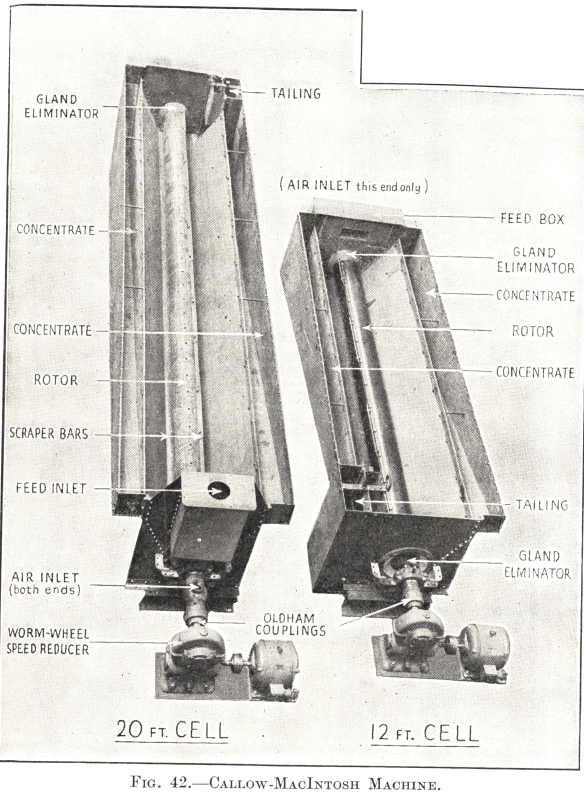
The rotor covering consists of a canvas “ sock ” or of a single sheet of perforated rubber. The latter is now far more commonly employed, since it lasts five times as long as the other, its life generally exceeding 18 months ; moreover it seldom becomes blinded with calcium carbonate, and requires an air pressure of only 2 lb. per square inch instead of the 3½-lb. pressure needed for canvas. The rubber sheets are made of pure gum about 5/64 in. thick with 225 holes per sq. in., the holes being made so as to allow the air to pass through while preventing the percolation of the pulp into the rotor in the event of a temporary shut-down. Two scraper bars of angle iron, 1½ by 1½ in., are bolted to opposite sides of the rotor on the top of the covering. They project 2 in. beyond the ends of the rotor, and their purpose is to keep in circulation any sand that settles on the bottom of the cell, at the same time protecting the porous medium from undue wear by contact with such material. Air is introduced into the rotor through one or both of the hollow shafts, which are connected by special inlet joints with the main supply. When both ends are employed for the admission of air, the rotor is usually divided into two sections by a central partition to enable each half to be controlled separately. The rotor is driven at a speed of about 15 r.p.m. by an individual motor connected with the shaft at one end of the cell; either a worm drive directly coupled to the motor or a chain drive coupled to the motor through a speed reducer can be employed.
The principle on which the Callow-Maclntosh Machine works is very similar to that of a Callow Cell. The air bubbles actually issue from the top of the rotor, where the hydraulic pressure is lowest, and spread out as they rise, their distribution through the pulp being quite as even and effective as when a flat blanket is used. The cell never needs “ flogging ” since the movement of the rotor prevents sand from settling on it, and the scraper bars keep in circulation the heavy particles that would otherwise settle on the bottom. The machine can, if necessary, handle ore as coarse as 20 mesh at a W/S ratio of 1/1 without choking.
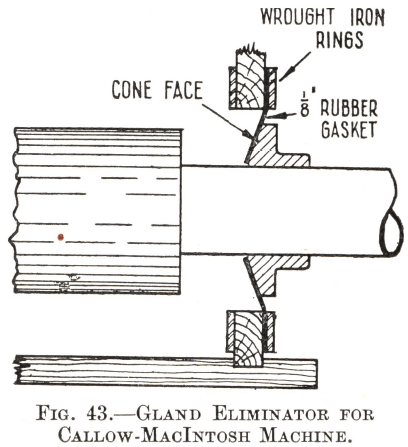
The control of a pneumatic cell is different from that of a machine of the mechanically agitated type, of which each cell is capable of performing the function of a high-speed conditioner. Little conditioning takes place once the pulp has entered a pneumatic cell, and provision must therefore be made for its proper preparation when employing heavy oils or chemical reagents which need a long contact period. The froth is usually maintained at a depth of 8 to 10 in., giving an effective pulp depth of 18 to 20 in. The very large volume of air bubbles released enables flotation to be effected more rapidly than in any other type of machine, the actual time required depending mostly on the degree to which the minerals have been rendered floatable. The upward stream of bubbles is so voluminous that, under ordinary conditions, the froth overflows the lips on both sides of the cell without the need of scrapers. For the same reason a considerable quantity of gangue is often carried over into the concentrate launder by mechanical entanglement with the bubbles, and one, sometimes two, subsequent cleaning operations are generally necessary in consequence. This, however, is by no means the rule ; a concentrate of high enough grade to be sent to the filtering section as a finished product can sometimes be made in a single “ rougher- cleaner ” cell. When the Callow-Macintosh Machine is run in this way (counter-current operation) a partitioned rotor is employed, since, by increasing the volume of air at the tailing-discharge end, the froth can be made to flow towards the head of the cell with the result that the minerals are concentrated there to the exclusion of gangue particles. The same effect can be obtained in a Callow Cell by regulating the admission of air to the individual pans in a similar way. If is often the practice, especially in counter-current operation, for the rougher to be followed by a scavenging cell, which is run with an excess of air as compared with the former, the froth being returned to the head of the first cell.
Callow-Macintosh Machines are made in lengths of 10, 15, and 20 ft. and in widths of 24, 30, and 36 in. with a rotor 9 in. in diameter. The vertical distance from the centre-line of the rotor to the overflow lip is about 24 in. The design of the machine, however, lends itself to the construction of larger sizes for big scale operations—i.e., up to a 30-ft. cell 48 in. wide with one or two 9-in. rotors. The 30- and 36-in. cells are sometimes fitted with rotors up to 15 in. in diameter to meet special requirements.
The capacity of the standard machine varies considerably according to the grade and character of the ore. The average capacity of a rougher or rougher-cleaner cell is from 8 to 12 tons of dry feed per foot of rotor length per 24 hours. When cleaning is practised, the tonnage per foot of total rotor length (roughers, scavengers, and cleaners) may vary from 4 tons for a slow-floating ore needing double cleaning to 10 tons for an easily-floated ore with single cleaning, the average being about 6 tons per foot of total rotor length. The cleaning section usually amounts to between one-quarter and one-half of the combined length of the roughing and scavenging cells. The width of cell employed depends on the character of the ore, the time of treatment, and the tonnage.
The quantity of air necessary varies from 5 to 7 cu. ft. per minute per square foot of aerating surface at 2- to 2¼-lb. pressure—that is, from 12 to 16.5 cu. ft. per minute per linear foot of rotor. With a Roots type blower the power consumption in respect of the air supply is about 12 h.p. per 1,000 cu. ft. of free air per minute at a pressure of 2 lb. per square inch. The power needed to turn the rotor averages 0.5 h.p.
Related: Check out what we think are the best milling machines as of 2022.
